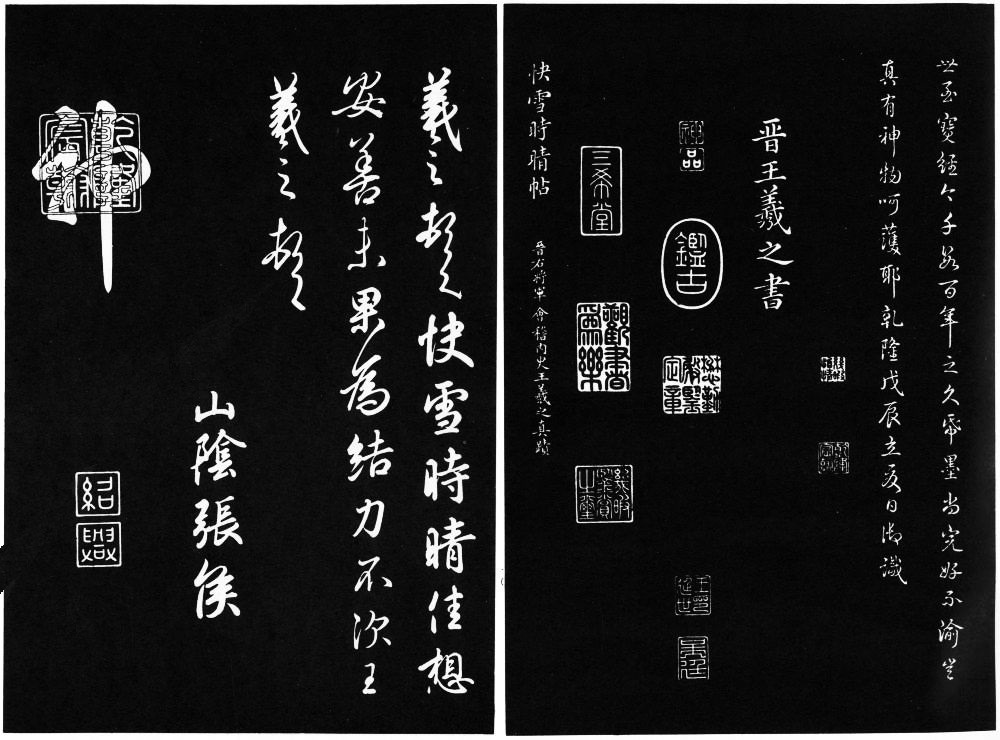Sanxitang fatie 三希堂法帖, full title (Yuke) Sanxitang shiqu baoji fatie (御刻)三希堂石渠寶笈法帖, is a collection of model calligraphies through history compiled during the high Qing period 清 (1644-1911). The name of the studio, "Hall of the Three Valuables" (Sanxitang 三希堂) refers to three outstanding artworks from the Jin period 晉 (265-420), namely Wang Xizhi's 王羲之 (303-361) Kuaixue shiqing tie 快雪時晴帖, Wang Xianzhi's 王獻之 (344-386) Zhongqiu tie 中秋帖, and Wang Xun's 王珣 (349-400) Boyuan tie 伯遠帖. The project includes artworks owned by the imperial household. The book of 32 volumes or booklets (in bound form) was compiled by Liang Shizheng 梁詩正 (1697-1763), Jiang Pu 蔣溥 (1708-1761), Wang Youdun 汪由敦 (1692-1758) and Ji Huang 稽璜 (1711-1794) and cut into stone and printed as a single book in 1750 (see also Shiqu baoji 石渠寶笈).
The collection includes reproductions of 340 excellent artworks of 134 persons from the Jin to the Ming period 明 (1368-1644) in different forms, either copies (mo 摹), prints (ke 刻), or rubbings (tuo 拓). In addition, the collection includes more than 200 dedications or accompanying texts (ti-ba 題跋) on individual calligraphies. Rubbings or reproduction of the Sanxitang fatie were produced in the "black-canvas style" (wujin tuo 烏金拓), a kind of negative, and usually presented to high dignitaries. These copies, imprinted with a red seal as "gift copies" (ciben 賜本), were therefore extremely rare and precious.
In 1792, a dedication (ba 跋) written by the Qianlong Emperor 乾隆帝 was added right after the calligraphies of Zhao Mengfu 趙孟頫 (1254-1322) in vol. 18. In 1839, the images were given frames with the character wan 卐 called "dragon edge" (longbian 龍邊) or "flower edge" (huabian 花邊). In the mid-19th century, the stone mould was already damaged, and at the turn of the century, five characters were missing from the imperial postscript (yuba 御跋).
Even if the Sanxitang fatie is a very exquisite piece of art reproduction, the selected calligraphies themselves are not well appraised, and there are several forgeries among them. The Beijing Library 北京圖書館 owns the first reproduction from the collection of Zhiyuan Zhuren 止園主人, in 32 volumes. Another set includes but 8 volumes (1, 5, 9, 15-16, 20, 25, 30) and is stored in the Yuegu Hall 閱古樓 of Beihai Park 北京市北海公園.
 |
Text of Wang Xizhi's 王羲之 Kuaixue shiqing tie 快雪時晴帖. From the facsimile reproduction Wan Yi 萬依, ed. (1984). Sanxitang fatie 三希堂法帖 (Beijing: Beijing ribao chubanshe). |